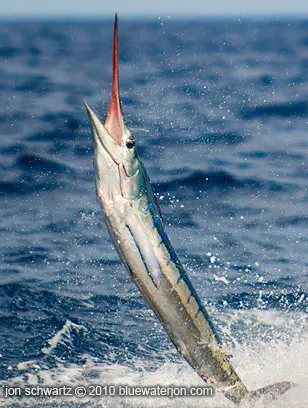|
|
Striped
Marlin: How to Catch and Release Big Fish
By Jon Schwartz
Striped
Marlin on the Pacific Coast of North America aren’t as big as
blues and black marlin, and are only half as big as striped
marlin get in New Zealand, but when fought on moderate
tackle (30-40 pound test), they put up a tremendous fight and
jump plenty. Most I’ve seen run between 100-150 pounds.
Their stripes are more pronounced than any other species of
marlin, and they can even reverse their pattern, from being dark
stripes on light skin, to light stripes on dark skin. Their
stripes become more pronounced when they are agitated and on the
hunt. When they are tired and exhausted, they lose their colors
and stripes.
 One popular method of sport fishing involves the use of circle
hooks with live bait. The hook ends up catching in the corner of
the mouth rather than in the gut and promotes healthier
releases. Mouth hooked fish fight better and jump more. Other
anglers troll skirted lures with j-hooks. Some use two hooks,
but some of the world’s most successful captains that I have
ridden with only use one hook, and one hook certainly increases
the odds of a quicker and safer release for the fish and the
person charged with releasing it. One popular method of sport fishing involves the use of circle
hooks with live bait. The hook ends up catching in the corner of
the mouth rather than in the gut and promotes healthier
releases. Mouth hooked fish fight better and jump more. Other
anglers troll skirted lures with j-hooks. Some use two hooks,
but some of the world’s most successful captains that I have
ridden with only use one hook, and one hook certainly increases
the odds of a quicker and safer release for the fish and the
person charged with releasing it.
While some choose to hoist the fish into the boat to pose with
it, it’s better for the fish to remain in the water. Removing
them from the water creates undue stress. I have swam with many
marlin and I can personally attest to the fact that fish that
have been removed from the water for a glory shot take longer to
recover, and some will not recover. Scientists, seasoned
captains and anglers, and conservation organizations such as The Billfish Foundation also contend that their protective
slime is removed when they are handled, and it’s nearly
impossible to bring a 150+ pound fish aboard and properly
support them. In addition, one has to tire the fish out more to
make them still
enough to handle and bring aboard.
 Often a fish is brought aboard because the captain and mate
assume that the angler wants it to happen; the captain and mates
I know would actually rather leave it in the water, but they
feel pressure to bring it aboard to please the angler. If you
can resist the temptation to have your marlin brought aboard,
tell the mate and captain in advance that you’d rather they keep
the fish in the water and release it in better shape. Often a fish is brought aboard because the captain and mate
assume that the angler wants it to happen; the captain and mates
I know would actually rather leave it in the water, but they
feel pressure to bring it aboard to please the angler. If you
can resist the temptation to have your marlin brought aboard,
tell the mate and captain in advance that you’d rather they keep
the fish in the water and release it in better shape.
To best protect marlin and ensure that they swim away in good
health, it’s best to fight them on sufficiently stout tackle,
and use fighting harnesses to maximize your leverage. These help
reduce fight time and enable the angler to bring the fish to
boat side for a quicker release. This might mean using 30-40
pound tackle for striped marlin in the 150 pound range, 50 pound
tackle for marlin up to 250 pounds, 60 pound tackle for fish
between 250 and 400 pounds, 80 pound tackle for fish 400-600
pounds, and 130 pound tackle for anything bigger.
Your captain and mate will be able to tell you the size of fish
that you will likely encounter in an area at a certain type of
year. That being said, of course a 1000 pound marlin can come up
and engulf a bait rigged on 50 pound test, but that’s rare. If
you’re like me, you’ll have more fun rigging right for the fish
you’re likely to encounter.
If you’d like more “face time” with your marlin, it may be
possible to do so without removing the fish from the water. The
fish can be brought alongside the boat while the boat is still
moving slowly in gear, and if the fish remains calm, the mate
sometimes can hold the fish’s bill close to the water’s surface,
so that water continues to flow through the fish’s gills. Once
you’ve got your face time, they simply release the bill and the
fish swims away in great shape.
|
|